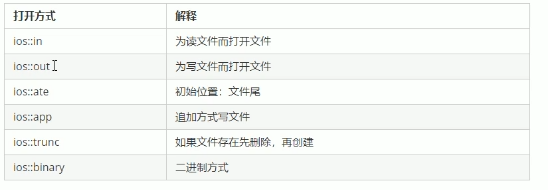程序运行时产生的数据都属于时数据,程序一旦运行结束都会被释放
通过文件可以将数据持久化
C++中对文件操作需要包含头文件fstream
文件类型分为两种:
1.文本文件·文件以文本的ASCII码形式存储在计算机中
2.二进制文件-文件以文本的二进制形式存储在计算机中,用户一般不能直接读懂它们
操作文件的三大类:
1,ofstream:写操作
2.ifstream:读操作
3.fstream:读写操作
5.1 文本文件
5.1.1 写文件
写文件步如下:
1.包含头文件
#include
2.创建流对象
ofstream ofs;
3.打开文件
ofs.open"文件路径",打开方式)
4.写数据
ofs<<“写入的数据"
5,关闭文件
ofs.close();
文件打开方式
 img
img
注意:文件特打开方式可以配合便用,利用引操作符
例如:用二进制方式写文件ios::binary| ios::out
1
2
3
4
5
6
7
8
9
10
11
12
13
14
15
16
17
18
19
20
21
|
#include <iostream>
#include <fstream>
using namespace std;
void test()
{
ofstream ofs;
ofs.open("test.txt", ios::out);
ofs << "姓名:张三" << endl;
ofs << "姓名:张三" << endl;
ofs << "姓名:张三" << endl;
ofs.close();
}
int main()
{
test();
}
|
5.1.2 读文件
读文件与写文件步骤相似,但是读取方式相对于比较多
读文件步如下:
1.包含头文件
#include
2.建流对象
ifstream ifs;
3.打开文件并判断文件是否打开成功
ifs.open("文件路径"打开方式):
4.读数据
四种方式读取
5.关闭文件
ifs.close();
总结:
读文件可以利用ifstream,或者fstream类
利用is_open函数可以判断文件是否打开成功
·close关闭文件I
1
2
3
4
5
6
7
8
9
10
11
12
13
14
15
16
17
18
19
20
21
22
23
24
25
26
27
28
29
30
31
32
33
34
35
36
37
38
39
40
41
42
43
44
45
46
|
#include <iostream>
#include <fstream>
#include <string>
using namespace std;
void test()
{
ifstream ifs;
ifs.open("test.txt",ios::in);
if (!ifs.is_open())
{
cout << "文件打开失败" << endl;
return;
}
char c;
while ((c = ifs.get()) !=EOF)
{
cout << c;
}
ifs.close();
}
int main()
{
test();
}
|
5.2 二进制文件
以二进制的方式对文件进行读写操作
打开方式要指定为ios::binary
5.2.1 写文件
二进制方式写文件主要利用流对象调用成员函数wite
函数原型:ostream& write(const char*buffer,int len);
参数解释:字符指针ouffer指向内存中一段存储空间。len是读写的字节数
1
2
3
4
5
6
7
8
9
10
11
12
13
14
15
16
17
18
19
20
21
22
23
| #include <iostream>
#include <fstream>
using namespace std;
class Person
{
public:
char name[64];
int age;
};
void test()
{
ofstream ofs("person.txt", ios::out | ios::binary);
Person p = { "张三",18 };
ofs.write((const char*)&p, sizeof(Person));
ofs.close();
}
int main()
{
test();
}
|
5.2.2 读文件
二进制方式读文件主要利用流对象调用成员函数rad
函数原型:
istream& read(char *buffer ,int len);
参数解释:字符指针buffer指向内存中一段存储空间。len是读写的字节数
1
2
3
4
5
6
7
8
9
10
11
12
13
14
15
16
17
18
19
20
21
22
23
24
25
26
27
28
29
30
31
32
33
|
#include <iostream>
#include <fstream>
using namespace std;
class Person
{
public:
char name[64];
int age;
};
void test()
{
ifstream ifs("person.txt", ios::in | ios::binary);
if (!ifs.is_open())
{
cout << "打开失败" << endl;
return;
}
Person p;
ifs.read((char*)&p, sizeof(Person));
cout << p.age << endl;
cout << p.name << endl;
ifs.close();
}
int main()
{
test();
}
|
